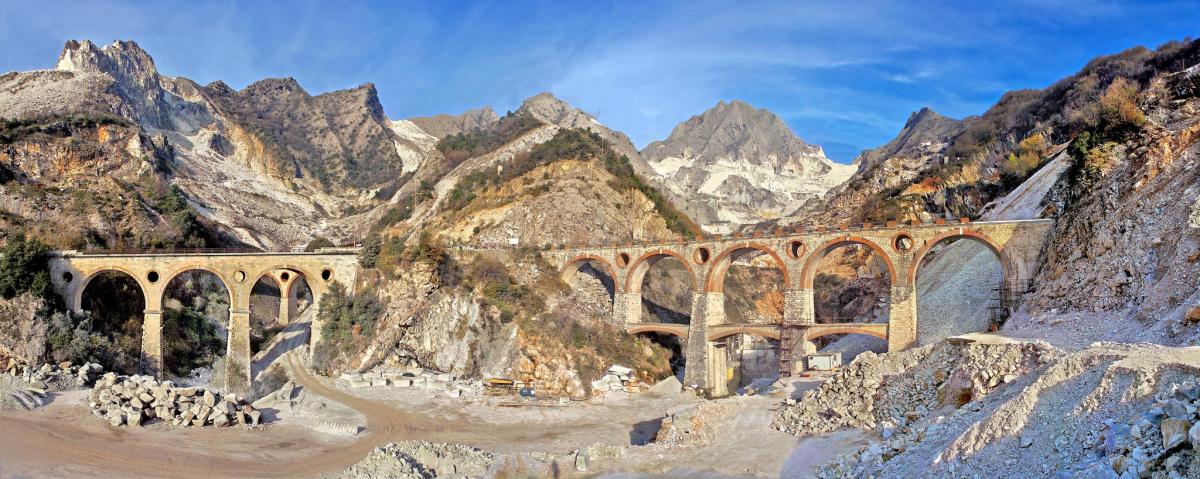




 27 February 2015
27 February 2015
 Caterina Pomini
Caterina Pomini
 8252
8252
Did you know that Luni – about 2 km northeast of the Ligurian-Tuscan border – is home to the remains of a Roman amphitheatre that could host up to 7000 people? Heading east towards the Apuan Alps, in the hamlet of Miseglia, you can visit the Fantiscritti Quarry, where Michelangelo used to select his blocks (Florence's David marble slab was cut from this beautiful quarry). Not tired of travelling? Then set out for Colonnata, 8 km away. Besides being famous for its Tuscan food specialties, it has very ancient origins; think that it was built around 40 BC for the housing of slaves employed in the Lunense marble quarrying.
But let's jump back to 177 BC, the year of Luni's founding. The city of Lunae - now disappeared - was a Roman military outpost for the campaigns against the Ligurians; according to Pliny the Elder, it became an agricultural colony after more than 40.000 Apuan Ligurians had been deported to Samnium and 2000 Roman colonists had been settled for the purpose of reclaiming the swamps. The settlement later turned into an important crossroads and the main port for Apuan marble exports; between the 1st and the 2nd century AD, Luni saw the renovation of many existing buildings and the construction of a large amphitheatre, whose remains can still be seen today. Luni Scavi - Luni's archaeological area - consists of the ruins of the ancient Roman city and the National Archaeological Museum (Tuesday to Sunday, 8.30am – 7.30pm) comprising artifacts discovered in local digs.
Miseglia's history is deeply rooted in the marble industry. As you drive along the road which takes you to the Fantiscritti Quarry, you will see three striking bridges (Ponti di Vara) over which the old Carrara Private Marble railway used to run. The Quarry owes its name to an ancient Roman bas-relief housed in the Accademia di Belle Arti, Carrara, depicting three small figures (fanti) surrounded by jumbled writings (scritti).
Originally adorning the interior of the Quarry, the artifact was relocated to the courtyard of Carrara's Accademia in 1863 and features two of the most illustrious tags in the history of graffiti: “Canova 1800” and “Gio Bolo 1595” (Giambologna's signature). Whether you are interested in the quarrying activity and the history of the Fantiscritti workers or not, we strongly recommend that you take this 30-minute tour: Fantiscritti is so magnificent it has been called “the Marble Cathedral” and is often used as space for performances. Visit www.cavamuseo.com for further information.
Surrounded by quarries and precisely situated in an area known as Gioia-Calagio, Colonnata has partly maintained its original features and has very narrow and steep streets; the Gioia Pit produces at least four different kinds of marble (white veined marble, arabescato, bianco brouillé and bardiglio), no wonder the village doorways, doorjambs and windows are all embellished with this mottled stone. The parish Church of San Bartolomeo (XVI century) dominates the village roofs and houses some remarkable works in white marble. Once you have reached the top of the village, you will be ready to taste Colonnata's traditional specialties and one of the most succulent pork fat delicacies ever: the Lardo – or rather the quarrymen's famous bread topper. Cured for months in basins made of local marble, Lardo di Colonnata has been prepared since Roman times and was granted Protected Geographical Indication (PGI) in 2004.
If your mouth is already watering, you can buy the real Lardo all year round at www.larderialaconca.it; if you happen to be in the Colonnata area around mid-August, don't miss the Sagra del Lardo (Lard Festival).
Need a car rental? Find further information at Florence car rent -
THIS SECTION
IS UNDER CONSTRUCTION